Comprehensive Case Study: Fortis Clinique Darne Hospital Performance
VerifiedAdded on 2021/02/20
|21
|7943
|58
Case Study
AI Summary
This case study examines Fortis Clinique Darne, a private hospital in Mauritius, focusing on its organizational structure, culture, and behavior. It includes a SWOT analysis to assess strengths, weaknesses, opportunities, and threats, followed by an evaluation of the hospital's performance. The study explores the quality of healthcare using Maxwell's classification and identifies ineffective healthcare scenarios. Furthermore, it analyzes how lean management tools can enhance performance and improve healthcare processes within the facility. The case study provides recommendations to improve business operational performance in the global context. The hospital's vision, mission, and values are outlined, along with the services it provides. The study also discusses the organizational structure implemented by Clinique Darne, its culture, and behaviors, along with the challenges faced. Finally, it focuses on the organizational behavior within the firm and its impact on decision-making and performance.
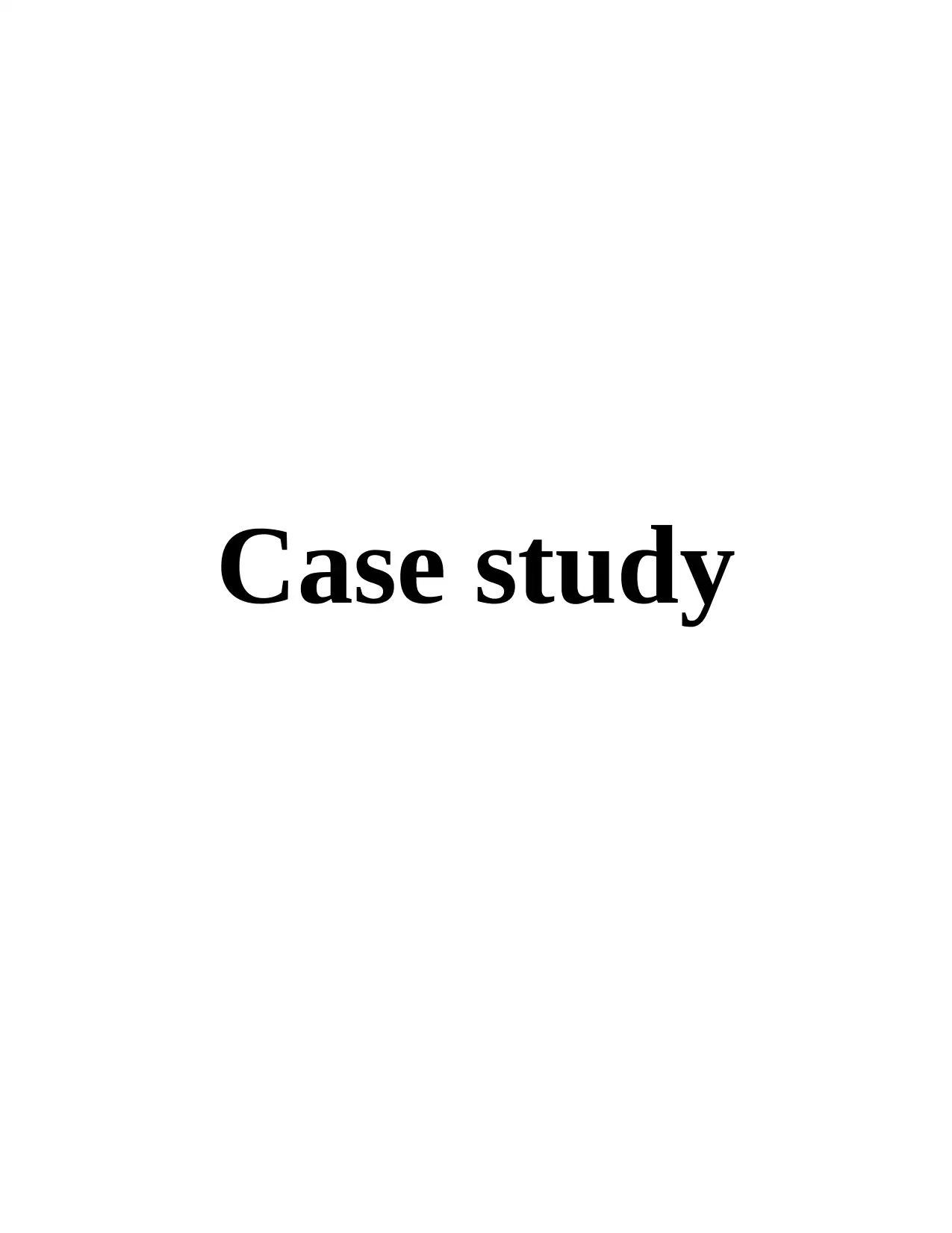
Case study
Paraphrase This Document
Need a fresh take? Get an instant paraphrase of this document with our AI Paraphraser
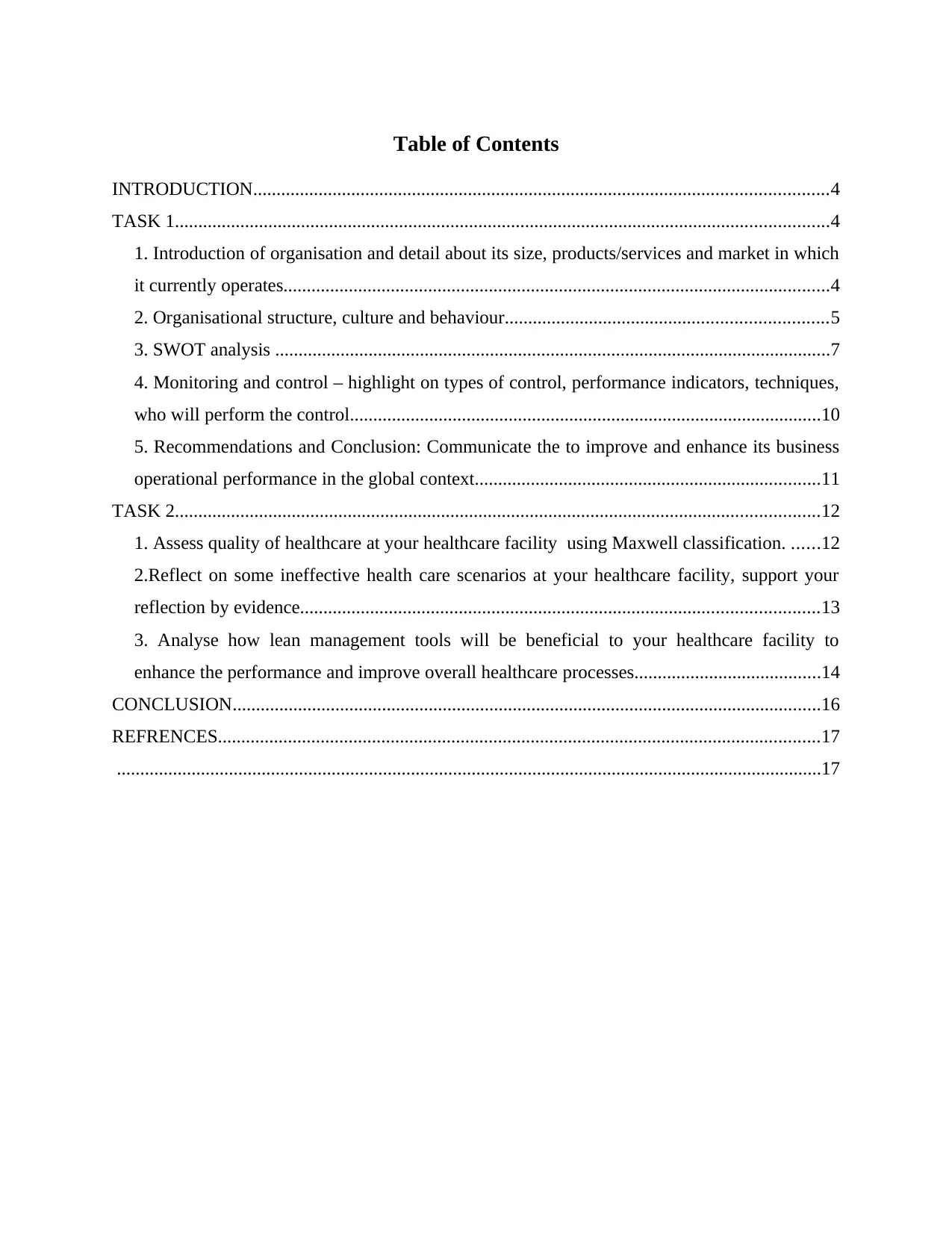
Table of Contents
INTRODUCTION...........................................................................................................................4
TASK 1............................................................................................................................................4
1. Introduction of organisation and detail about its size, products/services and market in which
it currently operates.....................................................................................................................4
2. Organisational structure, culture and behaviour.....................................................................5
3. SWOT analysis .......................................................................................................................7
4. Monitoring and control – highlight on types of control, performance indicators, techniques,
who will perform the control.....................................................................................................10
5. Recommendations and Conclusion: Communicate the to improve and enhance its business
operational performance in the global context..........................................................................11
TASK 2..........................................................................................................................................12
1. Assess quality of healthcare at your healthcare facility using Maxwell classification. ......12
2.Reflect on some ineffective health care scenarios at your healthcare facility, support your
reflection by evidence...............................................................................................................13
3. Analyse how lean management tools will be beneficial to your healthcare facility to
enhance the performance and improve overall healthcare processes........................................14
CONCLUSION..............................................................................................................................16
REFRENCES.................................................................................................................................17
.......................................................................................................................................................17
INTRODUCTION...........................................................................................................................4
TASK 1............................................................................................................................................4
1. Introduction of organisation and detail about its size, products/services and market in which
it currently operates.....................................................................................................................4
2. Organisational structure, culture and behaviour.....................................................................5
3. SWOT analysis .......................................................................................................................7
4. Monitoring and control – highlight on types of control, performance indicators, techniques,
who will perform the control.....................................................................................................10
5. Recommendations and Conclusion: Communicate the to improve and enhance its business
operational performance in the global context..........................................................................11
TASK 2..........................................................................................................................................12
1. Assess quality of healthcare at your healthcare facility using Maxwell classification. ......12
2.Reflect on some ineffective health care scenarios at your healthcare facility, support your
reflection by evidence...............................................................................................................13
3. Analyse how lean management tools will be beneficial to your healthcare facility to
enhance the performance and improve overall healthcare processes........................................14
CONCLUSION..............................................................................................................................16
REFRENCES.................................................................................................................................17
.......................................................................................................................................................17
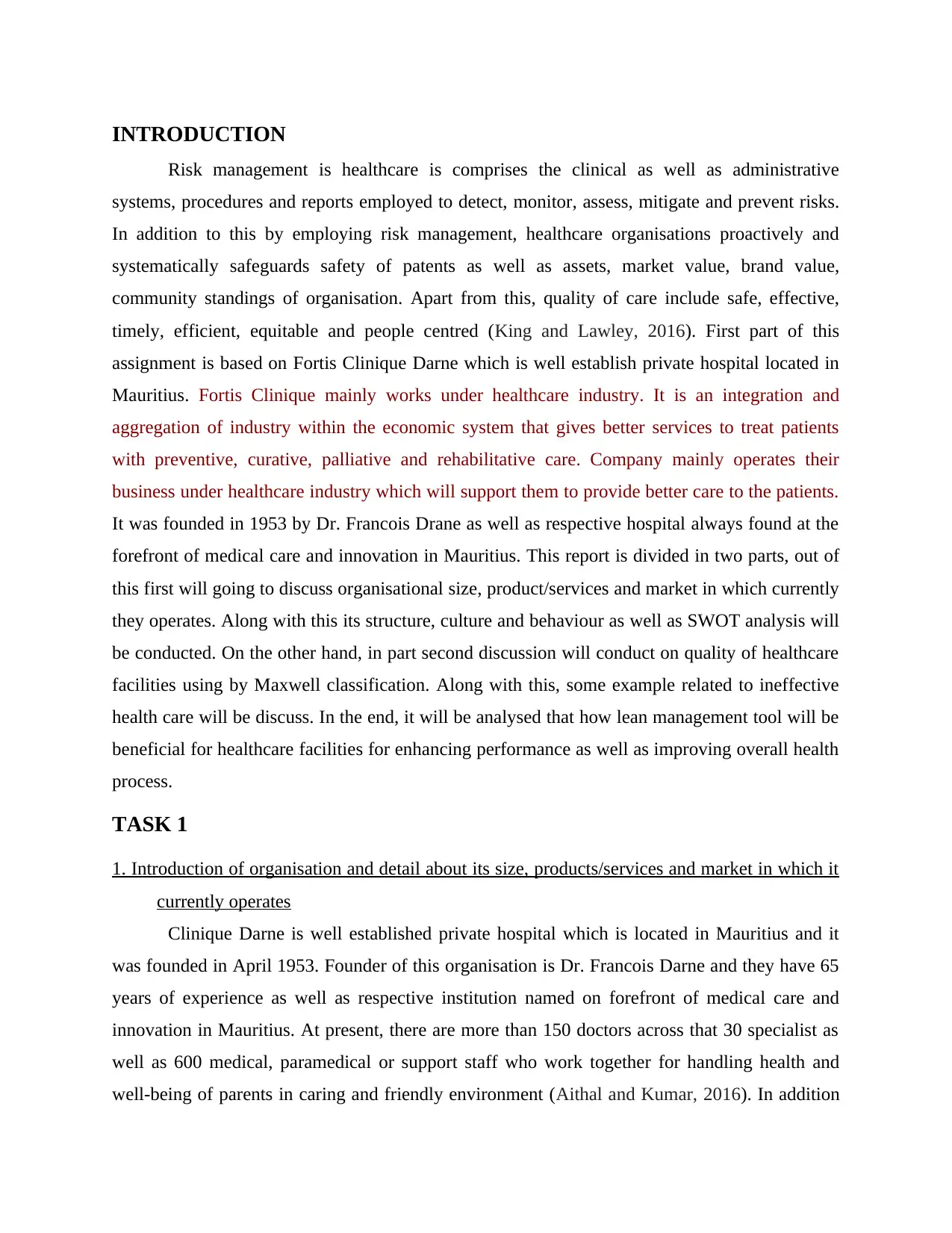
INTRODUCTION
Risk management is healthcare is comprises the clinical as well as administrative
systems, procedures and reports employed to detect, monitor, assess, mitigate and prevent risks.
In addition to this by employing risk management, healthcare organisations proactively and
systematically safeguards safety of patents as well as assets, market value, brand value,
community standings of organisation. Apart from this, quality of care include safe, effective,
timely, efficient, equitable and people centred (King and Lawley, 2016). First part of this
assignment is based on Fortis Clinique Darne which is well establish private hospital located in
Mauritius. Fortis Clinique mainly works under healthcare industry. It is an integration and
aggregation of industry within the economic system that gives better services to treat patients
with preventive, curative, palliative and rehabilitative care. Company mainly operates their
business under healthcare industry which will support them to provide better care to the patients.
It was founded in 1953 by Dr. Francois Drane as well as respective hospital always found at the
forefront of medical care and innovation in Mauritius. This report is divided in two parts, out of
this first will going to discuss organisational size, product/services and market in which currently
they operates. Along with this its structure, culture and behaviour as well as SWOT analysis will
be conducted. On the other hand, in part second discussion will conduct on quality of healthcare
facilities using by Maxwell classification. Along with this, some example related to ineffective
health care will be discuss. In the end, it will be analysed that how lean management tool will be
beneficial for healthcare facilities for enhancing performance as well as improving overall health
process.
TASK 1
1. Introduction of organisation and detail about its size, products/services and market in which it
currently operates
Clinique Darne is well established private hospital which is located in Mauritius and it
was founded in April 1953. Founder of this organisation is Dr. Francois Darne and they have 65
years of experience as well as respective institution named on forefront of medical care and
innovation in Mauritius. At present, there are more than 150 doctors across that 30 specialist as
well as 600 medical, paramedical or support staff who work together for handling health and
well-being of parents in caring and friendly environment (Aithal and Kumar, 2016). In addition
Risk management is healthcare is comprises the clinical as well as administrative
systems, procedures and reports employed to detect, monitor, assess, mitigate and prevent risks.
In addition to this by employing risk management, healthcare organisations proactively and
systematically safeguards safety of patents as well as assets, market value, brand value,
community standings of organisation. Apart from this, quality of care include safe, effective,
timely, efficient, equitable and people centred (King and Lawley, 2016). First part of this
assignment is based on Fortis Clinique Darne which is well establish private hospital located in
Mauritius. Fortis Clinique mainly works under healthcare industry. It is an integration and
aggregation of industry within the economic system that gives better services to treat patients
with preventive, curative, palliative and rehabilitative care. Company mainly operates their
business under healthcare industry which will support them to provide better care to the patients.
It was founded in 1953 by Dr. Francois Drane as well as respective hospital always found at the
forefront of medical care and innovation in Mauritius. This report is divided in two parts, out of
this first will going to discuss organisational size, product/services and market in which currently
they operates. Along with this its structure, culture and behaviour as well as SWOT analysis will
be conducted. On the other hand, in part second discussion will conduct on quality of healthcare
facilities using by Maxwell classification. Along with this, some example related to ineffective
health care will be discuss. In the end, it will be analysed that how lean management tool will be
beneficial for healthcare facilities for enhancing performance as well as improving overall health
process.
TASK 1
1. Introduction of organisation and detail about its size, products/services and market in which it
currently operates
Clinique Darne is well established private hospital which is located in Mauritius and it
was founded in April 1953. Founder of this organisation is Dr. Francois Darne and they have 65
years of experience as well as respective institution named on forefront of medical care and
innovation in Mauritius. At present, there are more than 150 doctors across that 30 specialist as
well as 600 medical, paramedical or support staff who work together for handling health and
well-being of parents in caring and friendly environment (Aithal and Kumar, 2016). In addition
⊘ This is a preview!⊘
Do you want full access?
Subscribe today to unlock all pages.

Trusted by 1+ million students worldwide
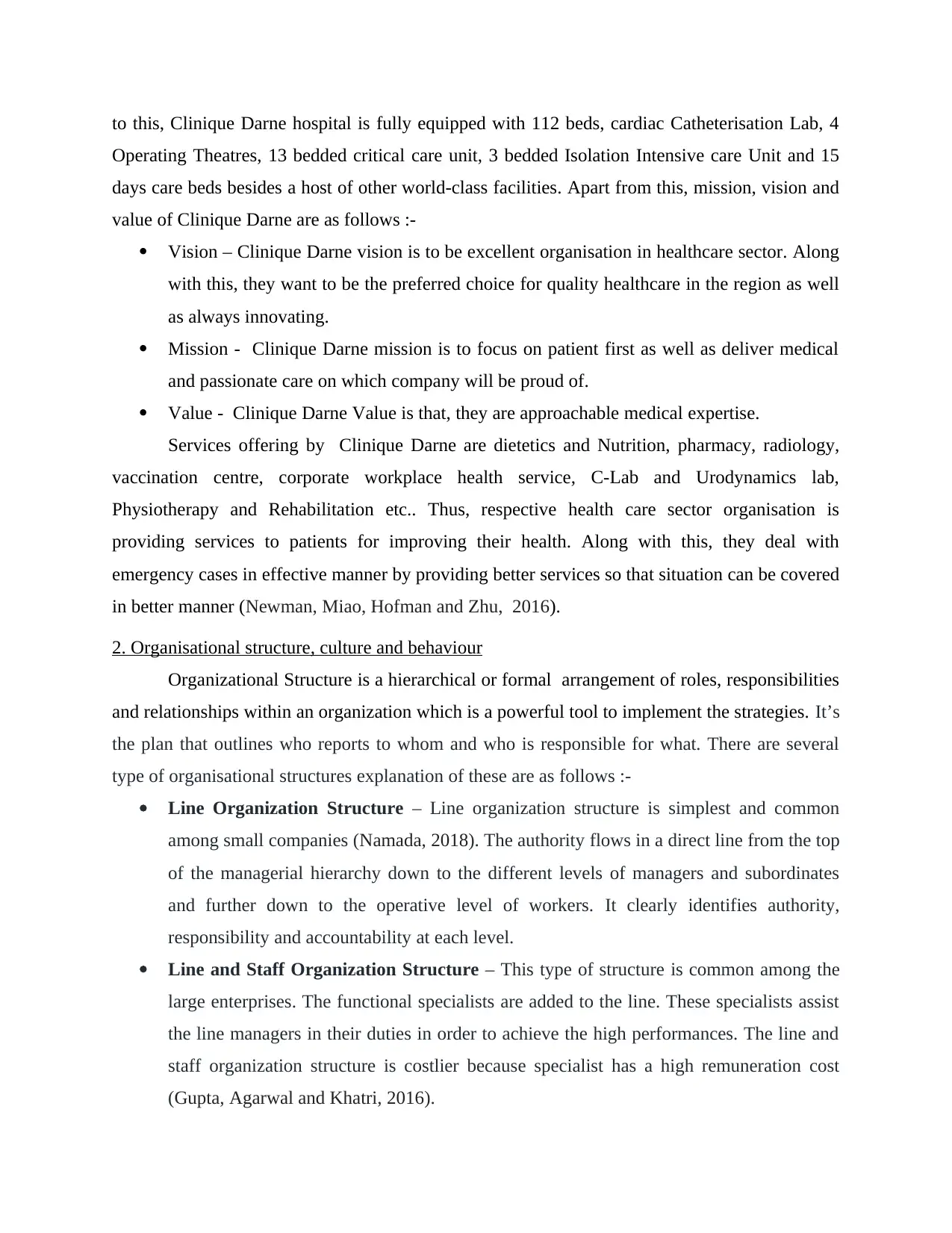
to this, Clinique Darne hospital is fully equipped with 112 beds, cardiac Catheterisation Lab, 4
Operating Theatres, 13 bedded critical care unit, 3 bedded Isolation Intensive care Unit and 15
days care beds besides a host of other world-class facilities. Apart from this, mission, vision and
value of Clinique Darne are as follows :-
Vision – Clinique Darne vision is to be excellent organisation in healthcare sector. Along
with this, they want to be the preferred choice for quality healthcare in the region as well
as always innovating.
Mission - Clinique Darne mission is to focus on patient first as well as deliver medical
and passionate care on which company will be proud of.
Value - Clinique Darne Value is that, they are approachable medical expertise.
Services offering by Clinique Darne are dietetics and Nutrition, pharmacy, radiology,
vaccination centre, corporate workplace health service, C-Lab and Urodynamics lab,
Physiotherapy and Rehabilitation etc.. Thus, respective health care sector organisation is
providing services to patients for improving their health. Along with this, they deal with
emergency cases in effective manner by providing better services so that situation can be covered
in better manner (Newman, Miao, Hofman and Zhu, 2016).
2. Organisational structure, culture and behaviour
Organizational Structure is a hierarchical or formal arrangement of roles, responsibilities
and relationships within an organization which is a powerful tool to implement the strategies. It’s
the plan that outlines who reports to whom and who is responsible for what. There are several
type of organisational structures explanation of these are as follows :-
Line Organization Structure – Line organization structure is simplest and common
among small companies (Namada, 2018). The authority flows in a direct line from the top
of the managerial hierarchy down to the different levels of managers and subordinates
and further down to the operative level of workers. It clearly identifies authority,
responsibility and accountability at each level.
Line and Staff Organization Structure – This type of structure is common among the
large enterprises. The functional specialists are added to the line. These specialists assist
the line managers in their duties in order to achieve the high performances. The line and
staff organization structure is costlier because specialist has a high remuneration cost
(Gupta, Agarwal and Khatri, 2016).
Operating Theatres, 13 bedded critical care unit, 3 bedded Isolation Intensive care Unit and 15
days care beds besides a host of other world-class facilities. Apart from this, mission, vision and
value of Clinique Darne are as follows :-
Vision – Clinique Darne vision is to be excellent organisation in healthcare sector. Along
with this, they want to be the preferred choice for quality healthcare in the region as well
as always innovating.
Mission - Clinique Darne mission is to focus on patient first as well as deliver medical
and passionate care on which company will be proud of.
Value - Clinique Darne Value is that, they are approachable medical expertise.
Services offering by Clinique Darne are dietetics and Nutrition, pharmacy, radiology,
vaccination centre, corporate workplace health service, C-Lab and Urodynamics lab,
Physiotherapy and Rehabilitation etc.. Thus, respective health care sector organisation is
providing services to patients for improving their health. Along with this, they deal with
emergency cases in effective manner by providing better services so that situation can be covered
in better manner (Newman, Miao, Hofman and Zhu, 2016).
2. Organisational structure, culture and behaviour
Organizational Structure is a hierarchical or formal arrangement of roles, responsibilities
and relationships within an organization which is a powerful tool to implement the strategies. It’s
the plan that outlines who reports to whom and who is responsible for what. There are several
type of organisational structures explanation of these are as follows :-
Line Organization Structure – Line organization structure is simplest and common
among small companies (Namada, 2018). The authority flows in a direct line from the top
of the managerial hierarchy down to the different levels of managers and subordinates
and further down to the operative level of workers. It clearly identifies authority,
responsibility and accountability at each level.
Line and Staff Organization Structure – This type of structure is common among the
large enterprises. The functional specialists are added to the line. These specialists assist
the line managers in their duties in order to achieve the high performances. The line and
staff organization structure is costlier because specialist has a high remuneration cost
(Gupta, Agarwal and Khatri, 2016).
Paraphrase This Document
Need a fresh take? Get an instant paraphrase of this document with our AI Paraphraser
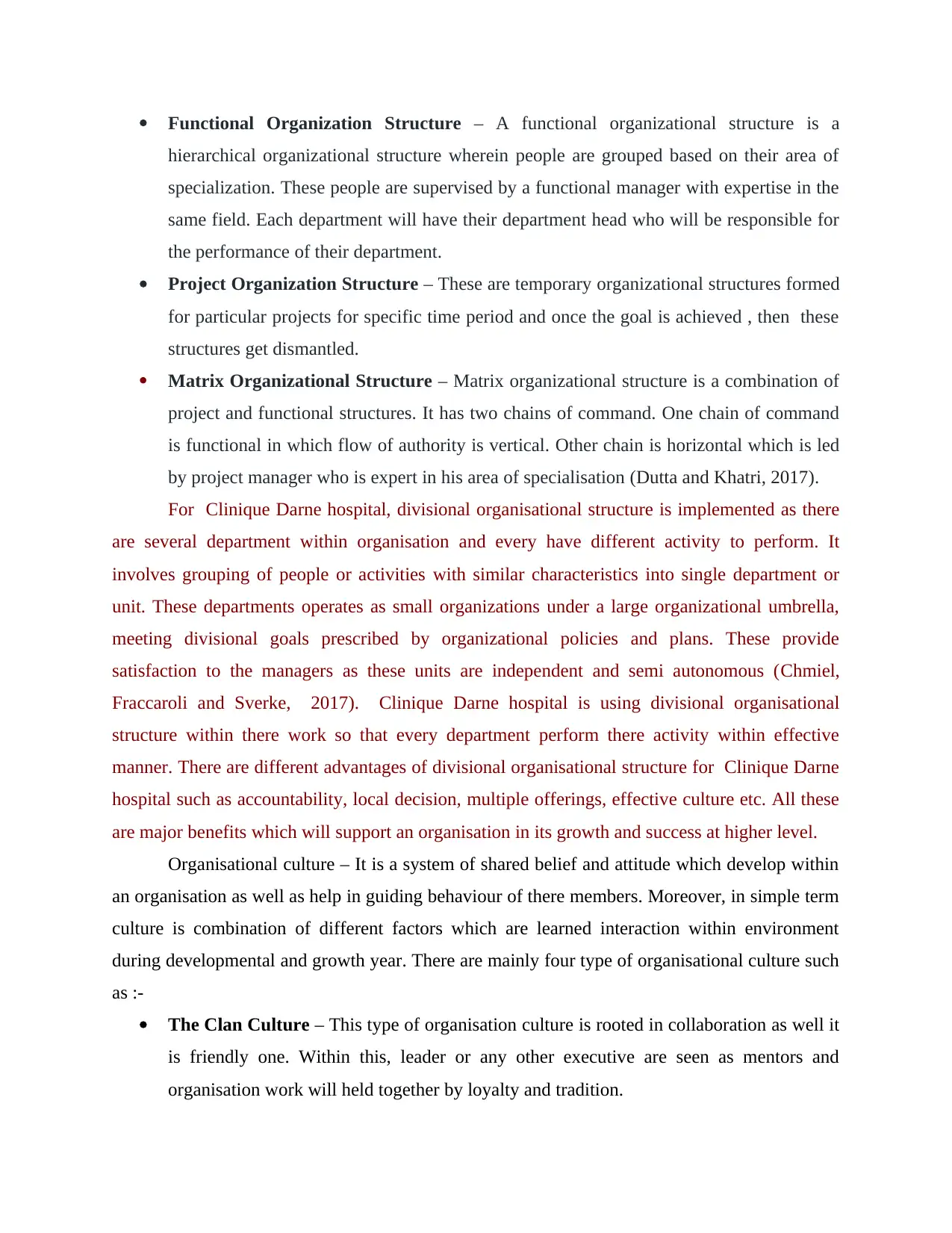
Functional Organization Structure – A functional organizational structure is a
hierarchical organizational structure wherein people are grouped based on their area of
specialization. These people are supervised by a functional manager with expertise in the
same field. Each department will have their department head who will be responsible for
the performance of their department.
Project Organization Structure – These are temporary organizational structures formed
for particular projects for specific time period and once the goal is achieved , then these
structures get dismantled.
Matrix Organizational Structure – Matrix organizational structure is a combination of
project and functional structures. It has two chains of command. One chain of command
is functional in which flow of authority is vertical. Other chain is horizontal which is led
by project manager who is expert in his area of specialisation (Dutta and Khatri, 2017).
For Clinique Darne hospital, divisional organisational structure is implemented as there
are several department within organisation and every have different activity to perform. It
involves grouping of people or activities with similar characteristics into single department or
unit. These departments operates as small organizations under a large organizational umbrella,
meeting divisional goals prescribed by organizational policies and plans. These provide
satisfaction to the managers as these units are independent and semi autonomous (Chmiel,
Fraccaroli and Sverke, 2017). Clinique Darne hospital is using divisional organisational
structure within there work so that every department perform there activity within effective
manner. There are different advantages of divisional organisational structure for Clinique Darne
hospital such as accountability, local decision, multiple offerings, effective culture etc. All these
are major benefits which will support an organisation in its growth and success at higher level.
Organisational culture – It is a system of shared belief and attitude which develop within
an organisation as well as help in guiding behaviour of there members. Moreover, in simple term
culture is combination of different factors which are learned interaction within environment
during developmental and growth year. There are mainly four type of organisational culture such
as :-
The Clan Culture – This type of organisation culture is rooted in collaboration as well it
is friendly one. Within this, leader or any other executive are seen as mentors and
organisation work will held together by loyalty and tradition.
hierarchical organizational structure wherein people are grouped based on their area of
specialization. These people are supervised by a functional manager with expertise in the
same field. Each department will have their department head who will be responsible for
the performance of their department.
Project Organization Structure – These are temporary organizational structures formed
for particular projects for specific time period and once the goal is achieved , then these
structures get dismantled.
Matrix Organizational Structure – Matrix organizational structure is a combination of
project and functional structures. It has two chains of command. One chain of command
is functional in which flow of authority is vertical. Other chain is horizontal which is led
by project manager who is expert in his area of specialisation (Dutta and Khatri, 2017).
For Clinique Darne hospital, divisional organisational structure is implemented as there
are several department within organisation and every have different activity to perform. It
involves grouping of people or activities with similar characteristics into single department or
unit. These departments operates as small organizations under a large organizational umbrella,
meeting divisional goals prescribed by organizational policies and plans. These provide
satisfaction to the managers as these units are independent and semi autonomous (Chmiel,
Fraccaroli and Sverke, 2017). Clinique Darne hospital is using divisional organisational
structure within there work so that every department perform there activity within effective
manner. There are different advantages of divisional organisational structure for Clinique Darne
hospital such as accountability, local decision, multiple offerings, effective culture etc. All these
are major benefits which will support an organisation in its growth and success at higher level.
Organisational culture – It is a system of shared belief and attitude which develop within
an organisation as well as help in guiding behaviour of there members. Moreover, in simple term
culture is combination of different factors which are learned interaction within environment
during developmental and growth year. There are mainly four type of organisational culture such
as :-
The Clan Culture – This type of organisation culture is rooted in collaboration as well it
is friendly one. Within this, leader or any other executive are seen as mentors and
organisation work will held together by loyalty and tradition.
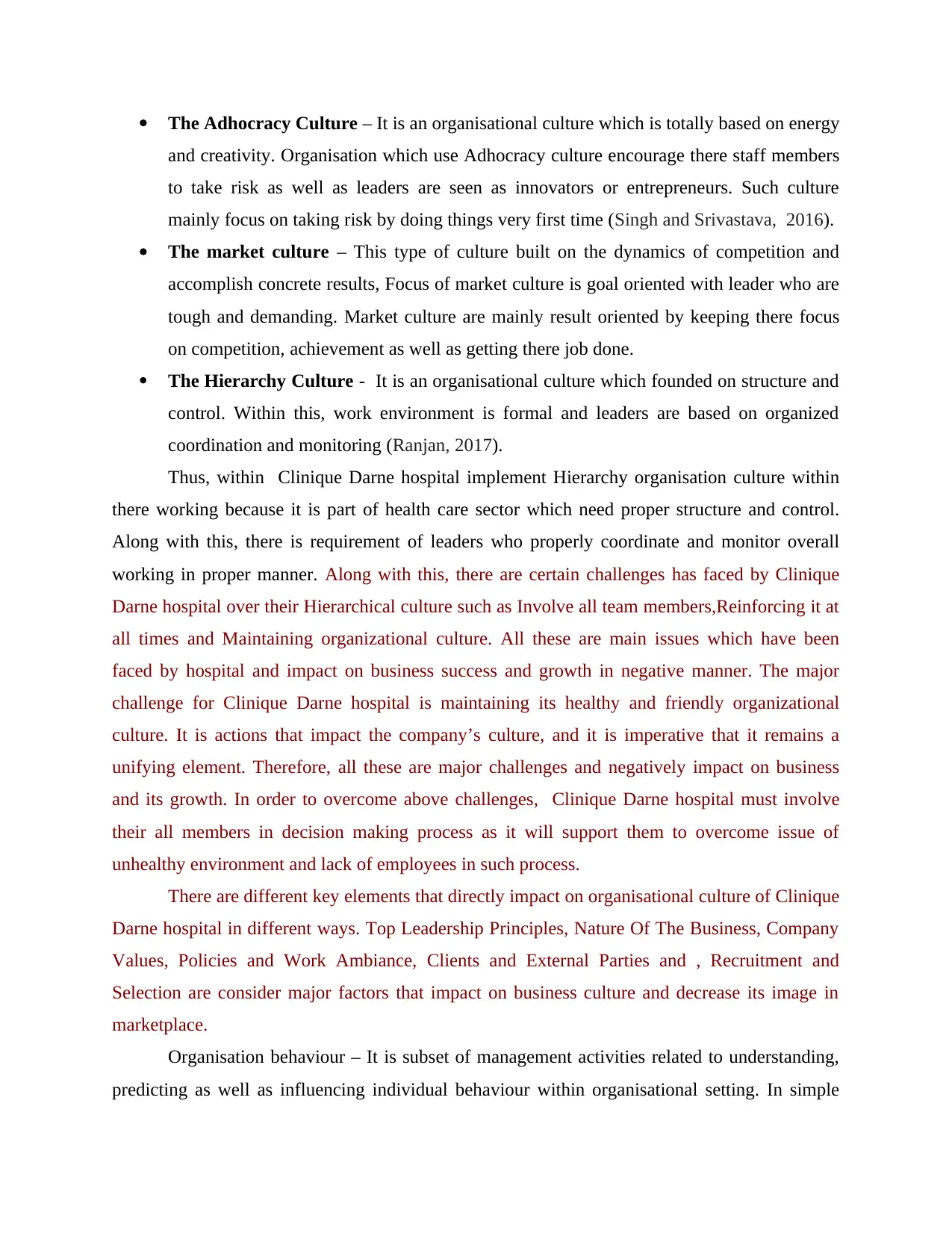
The Adhocracy Culture – It is an organisational culture which is totally based on energy
and creativity. Organisation which use Adhocracy culture encourage there staff members
to take risk as well as leaders are seen as innovators or entrepreneurs. Such culture
mainly focus on taking risk by doing things very first time (Singh and Srivastava, 2016).
The market culture – This type of culture built on the dynamics of competition and
accomplish concrete results, Focus of market culture is goal oriented with leader who are
tough and demanding. Market culture are mainly result oriented by keeping there focus
on competition, achievement as well as getting there job done.
The Hierarchy Culture - It is an organisational culture which founded on structure and
control. Within this, work environment is formal and leaders are based on organized
coordination and monitoring (Ranjan, 2017).
Thus, within Clinique Darne hospital implement Hierarchy organisation culture within
there working because it is part of health care sector which need proper structure and control.
Along with this, there is requirement of leaders who properly coordinate and monitor overall
working in proper manner. Along with this, there are certain challenges has faced by Clinique
Darne hospital over their Hierarchical culture such as Involve all team members,Reinforcing it at
all times and Maintaining organizational culture. All these are main issues which have been
faced by hospital and impact on business success and growth in negative manner. The major
challenge for Clinique Darne hospital is maintaining its healthy and friendly organizational
culture. It is actions that impact the company’s culture, and it is imperative that it remains a
unifying element. Therefore, all these are major challenges and negatively impact on business
and its growth. In order to overcome above challenges, Clinique Darne hospital must involve
their all members in decision making process as it will support them to overcome issue of
unhealthy environment and lack of employees in such process.
There are different key elements that directly impact on organisational culture of Clinique
Darne hospital in different ways. Top Leadership Principles, Nature Of The Business, Company
Values, Policies and Work Ambiance, Clients and External Parties and , Recruitment and
Selection are consider major factors that impact on business culture and decrease its image in
marketplace.
Organisation behaviour – It is subset of management activities related to understanding,
predicting as well as influencing individual behaviour within organisational setting. In simple
and creativity. Organisation which use Adhocracy culture encourage there staff members
to take risk as well as leaders are seen as innovators or entrepreneurs. Such culture
mainly focus on taking risk by doing things very first time (Singh and Srivastava, 2016).
The market culture – This type of culture built on the dynamics of competition and
accomplish concrete results, Focus of market culture is goal oriented with leader who are
tough and demanding. Market culture are mainly result oriented by keeping there focus
on competition, achievement as well as getting there job done.
The Hierarchy Culture - It is an organisational culture which founded on structure and
control. Within this, work environment is formal and leaders are based on organized
coordination and monitoring (Ranjan, 2017).
Thus, within Clinique Darne hospital implement Hierarchy organisation culture within
there working because it is part of health care sector which need proper structure and control.
Along with this, there is requirement of leaders who properly coordinate and monitor overall
working in proper manner. Along with this, there are certain challenges has faced by Clinique
Darne hospital over their Hierarchical culture such as Involve all team members,Reinforcing it at
all times and Maintaining organizational culture. All these are main issues which have been
faced by hospital and impact on business success and growth in negative manner. The major
challenge for Clinique Darne hospital is maintaining its healthy and friendly organizational
culture. It is actions that impact the company’s culture, and it is imperative that it remains a
unifying element. Therefore, all these are major challenges and negatively impact on business
and its growth. In order to overcome above challenges, Clinique Darne hospital must involve
their all members in decision making process as it will support them to overcome issue of
unhealthy environment and lack of employees in such process.
There are different key elements that directly impact on organisational culture of Clinique
Darne hospital in different ways. Top Leadership Principles, Nature Of The Business, Company
Values, Policies and Work Ambiance, Clients and External Parties and , Recruitment and
Selection are consider major factors that impact on business culture and decrease its image in
marketplace.
Organisation behaviour – It is subset of management activities related to understanding,
predicting as well as influencing individual behaviour within organisational setting. In simple
⊘ This is a preview!⊘
Do you want full access?
Subscribe today to unlock all pages.

Trusted by 1+ million students worldwide
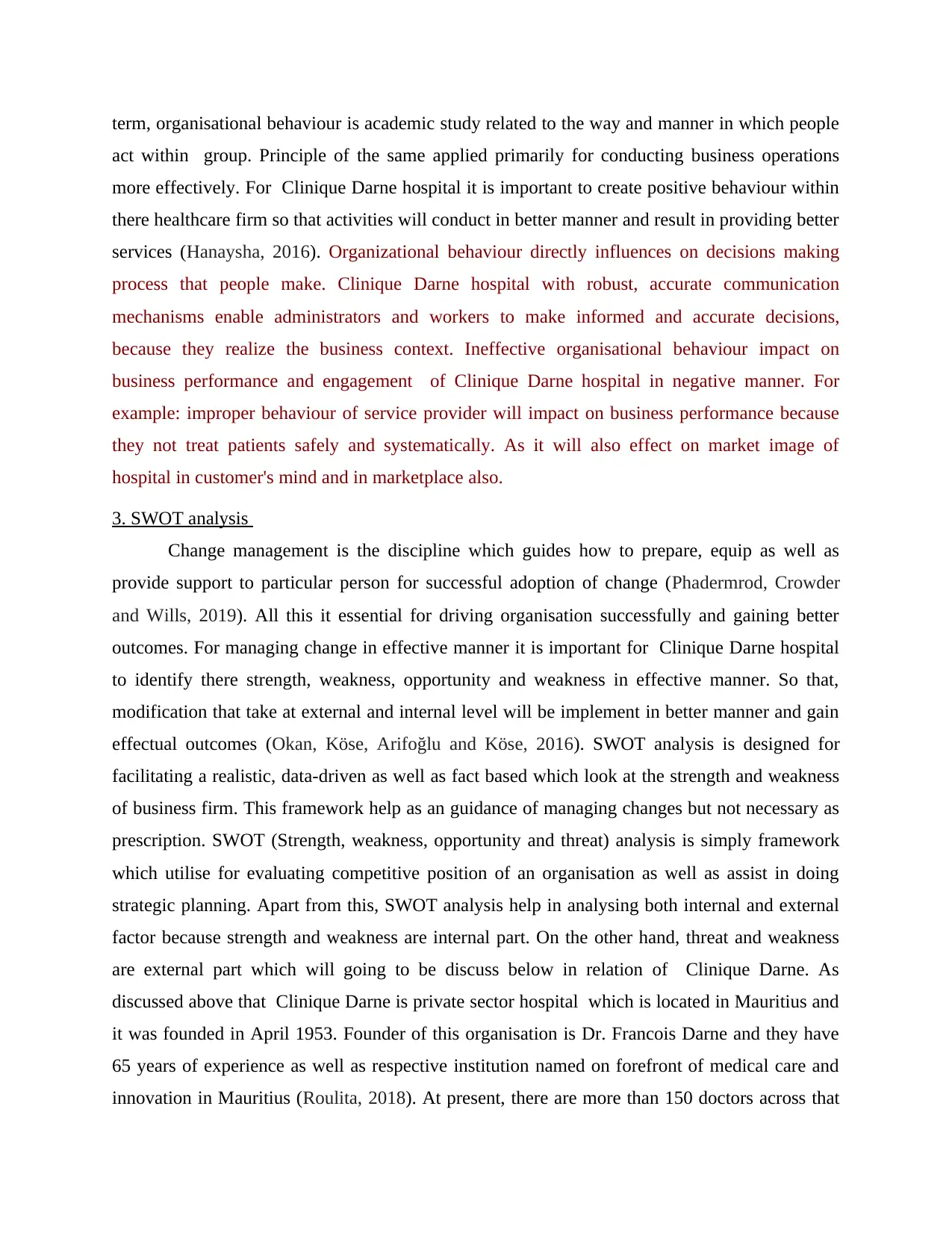
term, organisational behaviour is academic study related to the way and manner in which people
act within group. Principle of the same applied primarily for conducting business operations
more effectively. For Clinique Darne hospital it is important to create positive behaviour within
there healthcare firm so that activities will conduct in better manner and result in providing better
services (Hanaysha, 2016). Organizational behaviour directly influences on decisions making
process that people make. Clinique Darne hospital with robust, accurate communication
mechanisms enable administrators and workers to make informed and accurate decisions,
because they realize the business context. Ineffective organisational behaviour impact on
business performance and engagement of Clinique Darne hospital in negative manner. For
example: improper behaviour of service provider will impact on business performance because
they not treat patients safely and systematically. As it will also effect on market image of
hospital in customer's mind and in marketplace also.
3. SWOT analysis
Change management is the discipline which guides how to prepare, equip as well as
provide support to particular person for successful adoption of change (Phadermrod, Crowder
and Wills, 2019). All this it essential for driving organisation successfully and gaining better
outcomes. For managing change in effective manner it is important for Clinique Darne hospital
to identify there strength, weakness, opportunity and weakness in effective manner. So that,
modification that take at external and internal level will be implement in better manner and gain
effectual outcomes (Okan, Köse, Arifoğlu and Köse, 2016). SWOT analysis is designed for
facilitating a realistic, data-driven as well as fact based which look at the strength and weakness
of business firm. This framework help as an guidance of managing changes but not necessary as
prescription. SWOT (Strength, weakness, opportunity and threat) analysis is simply framework
which utilise for evaluating competitive position of an organisation as well as assist in doing
strategic planning. Apart from this, SWOT analysis help in analysing both internal and external
factor because strength and weakness are internal part. On the other hand, threat and weakness
are external part which will going to be discuss below in relation of Clinique Darne. As
discussed above that Clinique Darne is private sector hospital which is located in Mauritius and
it was founded in April 1953. Founder of this organisation is Dr. Francois Darne and they have
65 years of experience as well as respective institution named on forefront of medical care and
innovation in Mauritius (Roulita, 2018). At present, there are more than 150 doctors across that
act within group. Principle of the same applied primarily for conducting business operations
more effectively. For Clinique Darne hospital it is important to create positive behaviour within
there healthcare firm so that activities will conduct in better manner and result in providing better
services (Hanaysha, 2016). Organizational behaviour directly influences on decisions making
process that people make. Clinique Darne hospital with robust, accurate communication
mechanisms enable administrators and workers to make informed and accurate decisions,
because they realize the business context. Ineffective organisational behaviour impact on
business performance and engagement of Clinique Darne hospital in negative manner. For
example: improper behaviour of service provider will impact on business performance because
they not treat patients safely and systematically. As it will also effect on market image of
hospital in customer's mind and in marketplace also.
3. SWOT analysis
Change management is the discipline which guides how to prepare, equip as well as
provide support to particular person for successful adoption of change (Phadermrod, Crowder
and Wills, 2019). All this it essential for driving organisation successfully and gaining better
outcomes. For managing change in effective manner it is important for Clinique Darne hospital
to identify there strength, weakness, opportunity and weakness in effective manner. So that,
modification that take at external and internal level will be implement in better manner and gain
effectual outcomes (Okan, Köse, Arifoğlu and Köse, 2016). SWOT analysis is designed for
facilitating a realistic, data-driven as well as fact based which look at the strength and weakness
of business firm. This framework help as an guidance of managing changes but not necessary as
prescription. SWOT (Strength, weakness, opportunity and threat) analysis is simply framework
which utilise for evaluating competitive position of an organisation as well as assist in doing
strategic planning. Apart from this, SWOT analysis help in analysing both internal and external
factor because strength and weakness are internal part. On the other hand, threat and weakness
are external part which will going to be discuss below in relation of Clinique Darne. As
discussed above that Clinique Darne is private sector hospital which is located in Mauritius and
it was founded in April 1953. Founder of this organisation is Dr. Francois Darne and they have
65 years of experience as well as respective institution named on forefront of medical care and
innovation in Mauritius (Roulita, 2018). At present, there are more than 150 doctors across that
Paraphrase This Document
Need a fresh take? Get an instant paraphrase of this document with our AI Paraphraser
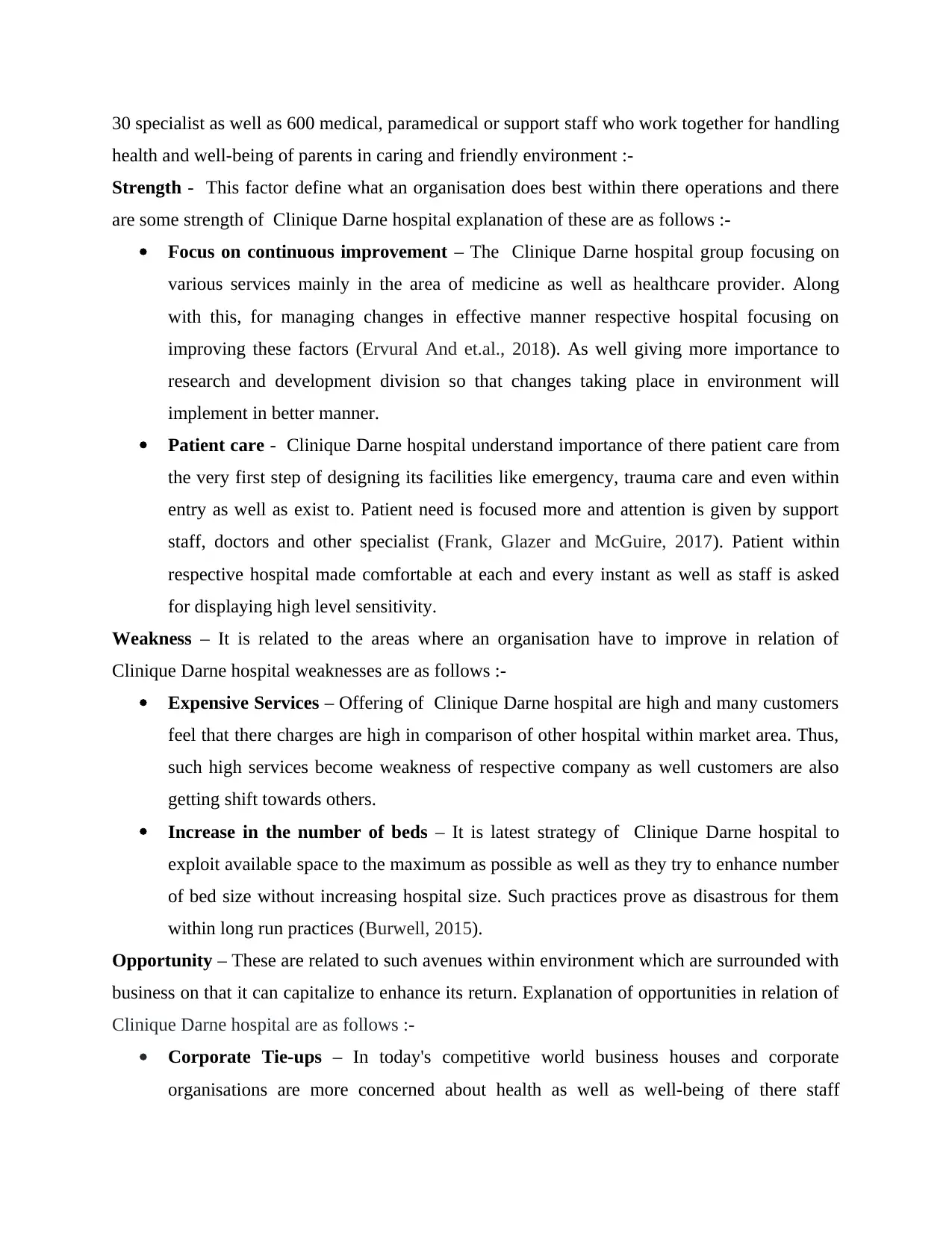
30 specialist as well as 600 medical, paramedical or support staff who work together for handling
health and well-being of parents in caring and friendly environment :-
Strength - This factor define what an organisation does best within there operations and there
are some strength of Clinique Darne hospital explanation of these are as follows :-
Focus on continuous improvement – The Clinique Darne hospital group focusing on
various services mainly in the area of medicine as well as healthcare provider. Along
with this, for managing changes in effective manner respective hospital focusing on
improving these factors (Ervural And et.al., 2018). As well giving more importance to
research and development division so that changes taking place in environment will
implement in better manner.
Patient care - Clinique Darne hospital understand importance of there patient care from
the very first step of designing its facilities like emergency, trauma care and even within
entry as well as exist to. Patient need is focused more and attention is given by support
staff, doctors and other specialist (Frank, Glazer and McGuire, 2017). Patient within
respective hospital made comfortable at each and every instant as well as staff is asked
for displaying high level sensitivity.
Weakness – It is related to the areas where an organisation have to improve in relation of
Clinique Darne hospital weaknesses are as follows :-
Expensive Services – Offering of Clinique Darne hospital are high and many customers
feel that there charges are high in comparison of other hospital within market area. Thus,
such high services become weakness of respective company as well customers are also
getting shift towards others.
Increase in the number of beds – It is latest strategy of Clinique Darne hospital to
exploit available space to the maximum as possible as well as they try to enhance number
of bed size without increasing hospital size. Such practices prove as disastrous for them
within long run practices (Burwell, 2015).
Opportunity – These are related to such avenues within environment which are surrounded with
business on that it can capitalize to enhance its return. Explanation of opportunities in relation of
Clinique Darne hospital are as follows :-
Corporate Tie-ups – In today's competitive world business houses and corporate
organisations are more concerned about health as well as well-being of there staff
health and well-being of parents in caring and friendly environment :-
Strength - This factor define what an organisation does best within there operations and there
are some strength of Clinique Darne hospital explanation of these are as follows :-
Focus on continuous improvement – The Clinique Darne hospital group focusing on
various services mainly in the area of medicine as well as healthcare provider. Along
with this, for managing changes in effective manner respective hospital focusing on
improving these factors (Ervural And et.al., 2018). As well giving more importance to
research and development division so that changes taking place in environment will
implement in better manner.
Patient care - Clinique Darne hospital understand importance of there patient care from
the very first step of designing its facilities like emergency, trauma care and even within
entry as well as exist to. Patient need is focused more and attention is given by support
staff, doctors and other specialist (Frank, Glazer and McGuire, 2017). Patient within
respective hospital made comfortable at each and every instant as well as staff is asked
for displaying high level sensitivity.
Weakness – It is related to the areas where an organisation have to improve in relation of
Clinique Darne hospital weaknesses are as follows :-
Expensive Services – Offering of Clinique Darne hospital are high and many customers
feel that there charges are high in comparison of other hospital within market area. Thus,
such high services become weakness of respective company as well customers are also
getting shift towards others.
Increase in the number of beds – It is latest strategy of Clinique Darne hospital to
exploit available space to the maximum as possible as well as they try to enhance number
of bed size without increasing hospital size. Such practices prove as disastrous for them
within long run practices (Burwell, 2015).
Opportunity – These are related to such avenues within environment which are surrounded with
business on that it can capitalize to enhance its return. Explanation of opportunities in relation of
Clinique Darne hospital are as follows :-
Corporate Tie-ups – In today's competitive world business houses and corporate
organisations are more concerned about health as well as well-being of there staff
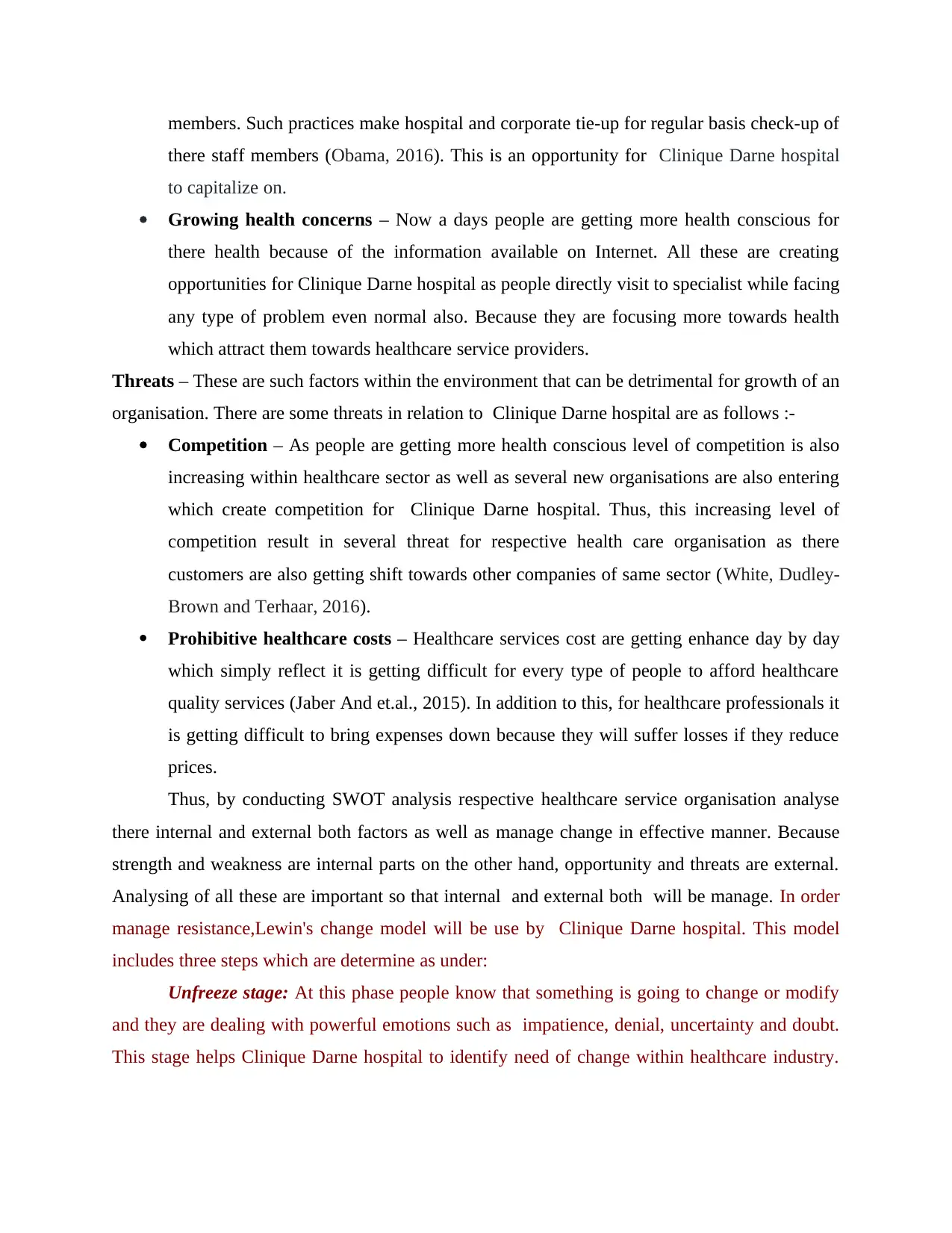
members. Such practices make hospital and corporate tie-up for regular basis check-up of
there staff members (Obama, 2016). This is an opportunity for Clinique Darne hospital
to capitalize on.
Growing health concerns – Now a days people are getting more health conscious for
there health because of the information available on Internet. All these are creating
opportunities for Clinique Darne hospital as people directly visit to specialist while facing
any type of problem even normal also. Because they are focusing more towards health
which attract them towards healthcare service providers.
Threats – These are such factors within the environment that can be detrimental for growth of an
organisation. There are some threats in relation to Clinique Darne hospital are as follows :-
Competition – As people are getting more health conscious level of competition is also
increasing within healthcare sector as well as several new organisations are also entering
which create competition for Clinique Darne hospital. Thus, this increasing level of
competition result in several threat for respective health care organisation as there
customers are also getting shift towards other companies of same sector (White, Dudley-
Brown and Terhaar, 2016).
Prohibitive healthcare costs – Healthcare services cost are getting enhance day by day
which simply reflect it is getting difficult for every type of people to afford healthcare
quality services (Jaber And et.al., 2015). In addition to this, for healthcare professionals it
is getting difficult to bring expenses down because they will suffer losses if they reduce
prices.
Thus, by conducting SWOT analysis respective healthcare service organisation analyse
there internal and external both factors as well as manage change in effective manner. Because
strength and weakness are internal parts on the other hand, opportunity and threats are external.
Analysing of all these are important so that internal and external both will be manage. In order
manage resistance,Lewin's change model will be use by Clinique Darne hospital. This model
includes three steps which are determine as under:
Unfreeze stage: At this phase people know that something is going to change or modify
and they are dealing with powerful emotions such as impatience, denial, uncertainty and doubt.
This stage helps Clinique Darne hospital to identify need of change within healthcare industry.
there staff members (Obama, 2016). This is an opportunity for Clinique Darne hospital
to capitalize on.
Growing health concerns – Now a days people are getting more health conscious for
there health because of the information available on Internet. All these are creating
opportunities for Clinique Darne hospital as people directly visit to specialist while facing
any type of problem even normal also. Because they are focusing more towards health
which attract them towards healthcare service providers.
Threats – These are such factors within the environment that can be detrimental for growth of an
organisation. There are some threats in relation to Clinique Darne hospital are as follows :-
Competition – As people are getting more health conscious level of competition is also
increasing within healthcare sector as well as several new organisations are also entering
which create competition for Clinique Darne hospital. Thus, this increasing level of
competition result in several threat for respective health care organisation as there
customers are also getting shift towards other companies of same sector (White, Dudley-
Brown and Terhaar, 2016).
Prohibitive healthcare costs – Healthcare services cost are getting enhance day by day
which simply reflect it is getting difficult for every type of people to afford healthcare
quality services (Jaber And et.al., 2015). In addition to this, for healthcare professionals it
is getting difficult to bring expenses down because they will suffer losses if they reduce
prices.
Thus, by conducting SWOT analysis respective healthcare service organisation analyse
there internal and external both factors as well as manage change in effective manner. Because
strength and weakness are internal parts on the other hand, opportunity and threats are external.
Analysing of all these are important so that internal and external both will be manage. In order
manage resistance,Lewin's change model will be use by Clinique Darne hospital. This model
includes three steps which are determine as under:
Unfreeze stage: At this phase people know that something is going to change or modify
and they are dealing with powerful emotions such as impatience, denial, uncertainty and doubt.
This stage helps Clinique Darne hospital to identify need of change within healthcare industry.
⊘ This is a preview!⊘
Do you want full access?
Subscribe today to unlock all pages.

Trusted by 1+ million students worldwide
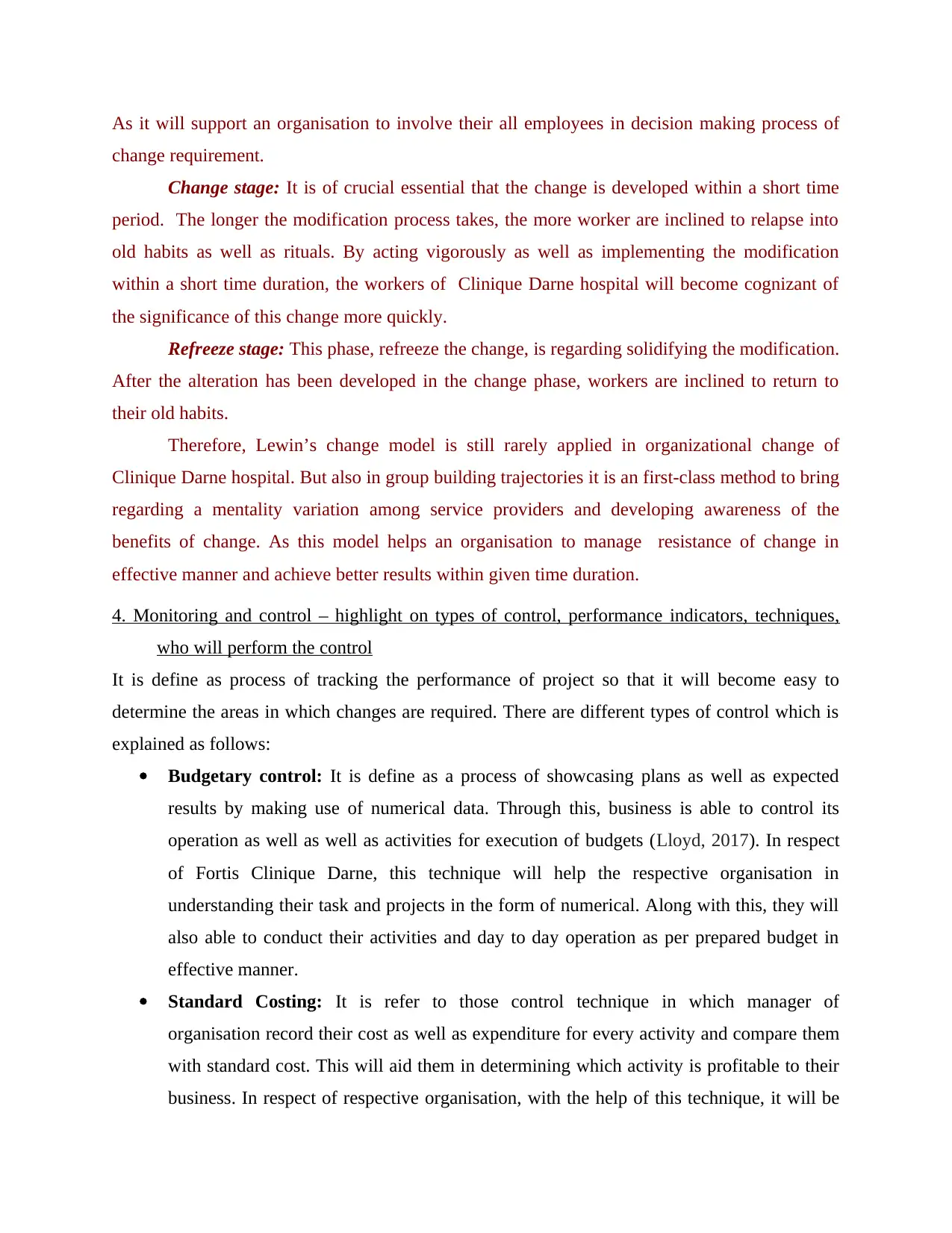
As it will support an organisation to involve their all employees in decision making process of
change requirement.
Change stage: It is of crucial essential that the change is developed within a short time
period. The longer the modification process takes, the more worker are inclined to relapse into
old habits as well as rituals. By acting vigorously as well as implementing the modification
within a short time duration, the workers of Clinique Darne hospital will become cognizant of
the significance of this change more quickly.
Refreeze stage: This phase, refreeze the change, is regarding solidifying the modification.
After the alteration has been developed in the change phase, workers are inclined to return to
their old habits.
Therefore, Lewin’s change model is still rarely applied in organizational change of
Clinique Darne hospital. But also in group building trajectories it is an first-class method to bring
regarding a mentality variation among service providers and developing awareness of the
benefits of change. As this model helps an organisation to manage resistance of change in
effective manner and achieve better results within given time duration.
4. Monitoring and control – highlight on types of control, performance indicators, techniques,
who will perform the control
It is define as process of tracking the performance of project so that it will become easy to
determine the areas in which changes are required. There are different types of control which is
explained as follows:
Budgetary control: It is define as a process of showcasing plans as well as expected
results by making use of numerical data. Through this, business is able to control its
operation as well as well as activities for execution of budgets (Lloyd, 2017). In respect
of Fortis Clinique Darne, this technique will help the respective organisation in
understanding their task and projects in the form of numerical. Along with this, they will
also able to conduct their activities and day to day operation as per prepared budget in
effective manner.
Standard Costing: It is refer to those control technique in which manager of
organisation record their cost as well as expenditure for every activity and compare them
with standard cost. This will aid them in determining which activity is profitable to their
business. In respect of respective organisation, with the help of this technique, it will be
change requirement.
Change stage: It is of crucial essential that the change is developed within a short time
period. The longer the modification process takes, the more worker are inclined to relapse into
old habits as well as rituals. By acting vigorously as well as implementing the modification
within a short time duration, the workers of Clinique Darne hospital will become cognizant of
the significance of this change more quickly.
Refreeze stage: This phase, refreeze the change, is regarding solidifying the modification.
After the alteration has been developed in the change phase, workers are inclined to return to
their old habits.
Therefore, Lewin’s change model is still rarely applied in organizational change of
Clinique Darne hospital. But also in group building trajectories it is an first-class method to bring
regarding a mentality variation among service providers and developing awareness of the
benefits of change. As this model helps an organisation to manage resistance of change in
effective manner and achieve better results within given time duration.
4. Monitoring and control – highlight on types of control, performance indicators, techniques,
who will perform the control
It is define as process of tracking the performance of project so that it will become easy to
determine the areas in which changes are required. There are different types of control which is
explained as follows:
Budgetary control: It is define as a process of showcasing plans as well as expected
results by making use of numerical data. Through this, business is able to control its
operation as well as well as activities for execution of budgets (Lloyd, 2017). In respect
of Fortis Clinique Darne, this technique will help the respective organisation in
understanding their task and projects in the form of numerical. Along with this, they will
also able to conduct their activities and day to day operation as per prepared budget in
effective manner.
Standard Costing: It is refer to those control technique in which manager of
organisation record their cost as well as expenditure for every activity and compare them
with standard cost. This will aid them in determining which activity is profitable to their
business. In respect of respective organisation, with the help of this technique, it will be
Paraphrase This Document
Need a fresh take? Get an instant paraphrase of this document with our AI Paraphraser
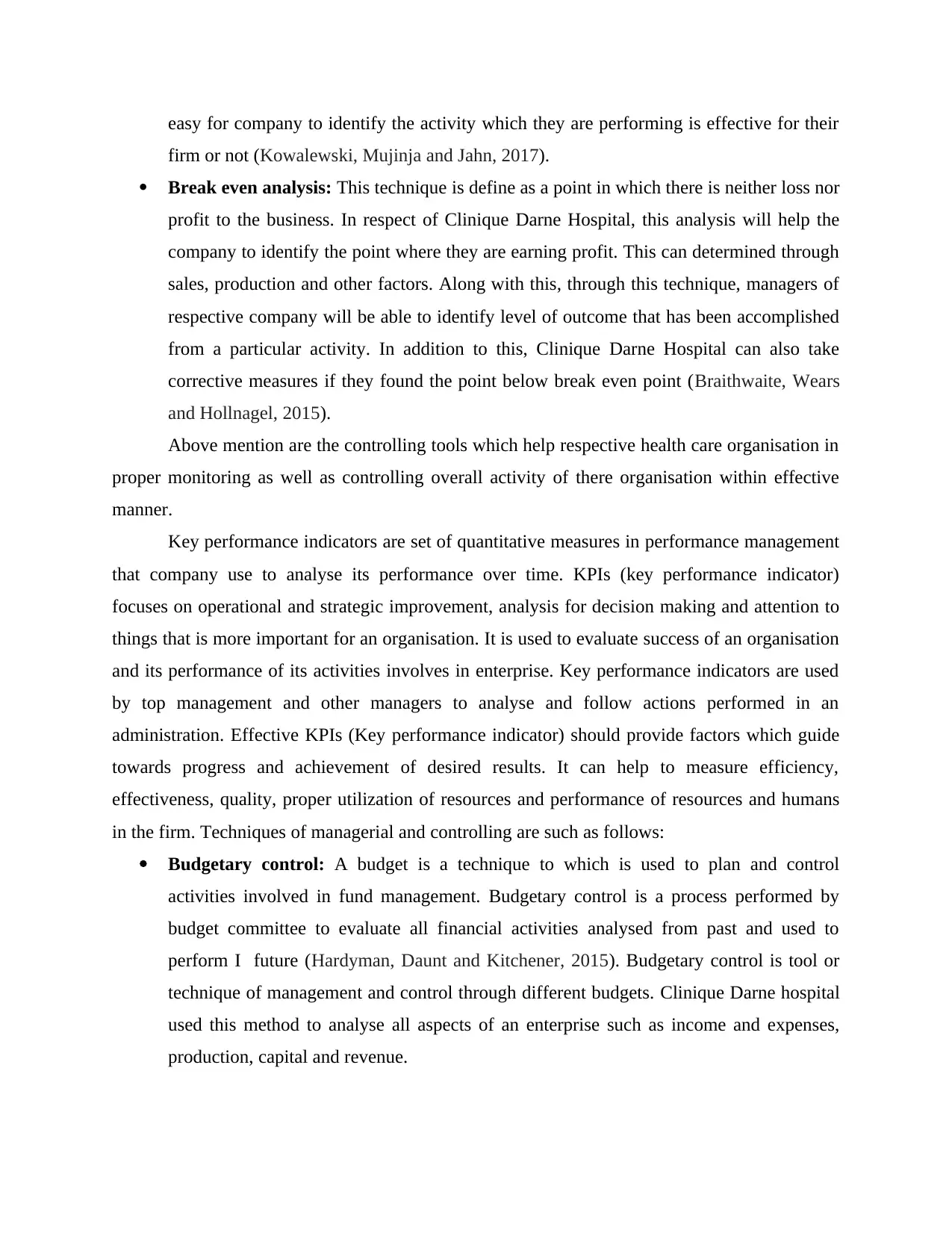
easy for company to identify the activity which they are performing is effective for their
firm or not (Kowalewski, Mujinja and Jahn, 2017).
Break even analysis: This technique is define as a point in which there is neither loss nor
profit to the business. In respect of Clinique Darne Hospital, this analysis will help the
company to identify the point where they are earning profit. This can determined through
sales, production and other factors. Along with this, through this technique, managers of
respective company will be able to identify level of outcome that has been accomplished
from a particular activity. In addition to this, Clinique Darne Hospital can also take
corrective measures if they found the point below break even point (Braithwaite, Wears
and Hollnagel, 2015).
Above mention are the controlling tools which help respective health care organisation in
proper monitoring as well as controlling overall activity of there organisation within effective
manner.
Key performance indicators are set of quantitative measures in performance management
that company use to analyse its performance over time. KPIs (key performance indicator)
focuses on operational and strategic improvement, analysis for decision making and attention to
things that is more important for an organisation. It is used to evaluate success of an organisation
and its performance of its activities involves in enterprise. Key performance indicators are used
by top management and other managers to analyse and follow actions performed in an
administration. Effective KPIs (Key performance indicator) should provide factors which guide
towards progress and achievement of desired results. It can help to measure efficiency,
effectiveness, quality, proper utilization of resources and performance of resources and humans
in the firm. Techniques of managerial and controlling are such as follows:
Budgetary control: A budget is a technique to which is used to plan and control
activities involved in fund management. Budgetary control is a process performed by
budget committee to evaluate all financial activities analysed from past and used to
perform I future (Hardyman, Daunt and Kitchener, 2015). Budgetary control is tool or
technique of management and control through different budgets. Clinique Darne hospital
used this method to analyse all aspects of an enterprise such as income and expenses,
production, capital and revenue.
firm or not (Kowalewski, Mujinja and Jahn, 2017).
Break even analysis: This technique is define as a point in which there is neither loss nor
profit to the business. In respect of Clinique Darne Hospital, this analysis will help the
company to identify the point where they are earning profit. This can determined through
sales, production and other factors. Along with this, through this technique, managers of
respective company will be able to identify level of outcome that has been accomplished
from a particular activity. In addition to this, Clinique Darne Hospital can also take
corrective measures if they found the point below break even point (Braithwaite, Wears
and Hollnagel, 2015).
Above mention are the controlling tools which help respective health care organisation in
proper monitoring as well as controlling overall activity of there organisation within effective
manner.
Key performance indicators are set of quantitative measures in performance management
that company use to analyse its performance over time. KPIs (key performance indicator)
focuses on operational and strategic improvement, analysis for decision making and attention to
things that is more important for an organisation. It is used to evaluate success of an organisation
and its performance of its activities involves in enterprise. Key performance indicators are used
by top management and other managers to analyse and follow actions performed in an
administration. Effective KPIs (Key performance indicator) should provide factors which guide
towards progress and achievement of desired results. It can help to measure efficiency,
effectiveness, quality, proper utilization of resources and performance of resources and humans
in the firm. Techniques of managerial and controlling are such as follows:
Budgetary control: A budget is a technique to which is used to plan and control
activities involved in fund management. Budgetary control is a process performed by
budget committee to evaluate all financial activities analysed from past and used to
perform I future (Hardyman, Daunt and Kitchener, 2015). Budgetary control is tool or
technique of management and control through different budgets. Clinique Darne hospital
used this method to analyse all aspects of an enterprise such as income and expenses,
production, capital and revenue.
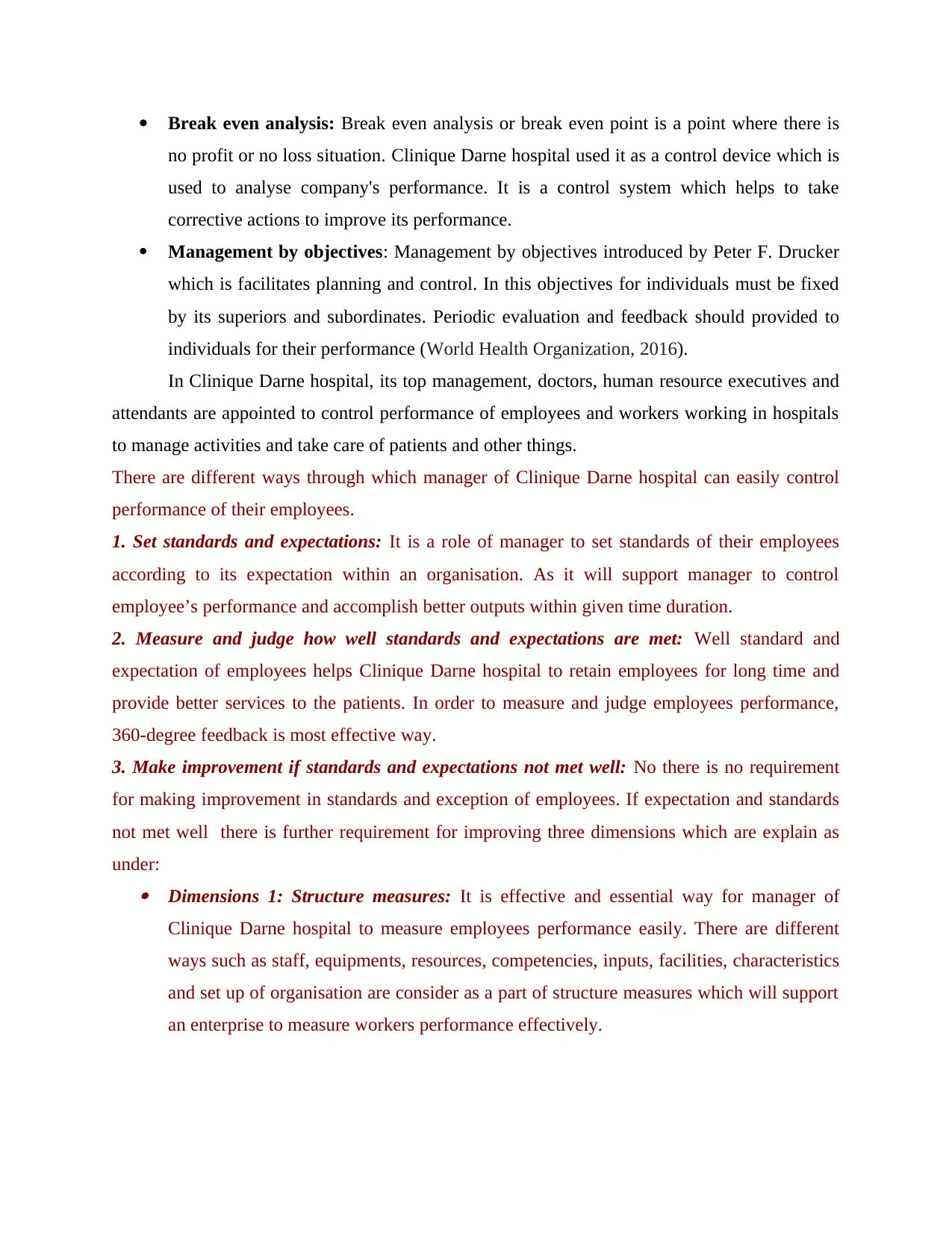
Break even analysis: Break even analysis or break even point is a point where there is
no profit or no loss situation. Clinique Darne hospital used it as a control device which is
used to analyse company's performance. It is a control system which helps to take
corrective actions to improve its performance.
Management by objectives: Management by objectives introduced by Peter F. Drucker
which is facilitates planning and control. In this objectives for individuals must be fixed
by its superiors and subordinates. Periodic evaluation and feedback should provided to
individuals for their performance (World Health Organization, 2016).
In Clinique Darne hospital, its top management, doctors, human resource executives and
attendants are appointed to control performance of employees and workers working in hospitals
to manage activities and take care of patients and other things.
There are different ways through which manager of Clinique Darne hospital can easily control
performance of their employees.
1. Set standards and expectations: It is a role of manager to set standards of their employees
according to its expectation within an organisation. As it will support manager to control
employee’s performance and accomplish better outputs within given time duration.
2. Measure and judge how well standards and expectations are met: Well standard and
expectation of employees helps Clinique Darne hospital to retain employees for long time and
provide better services to the patients. In order to measure and judge employees performance,
360-degree feedback is most effective way.
3. Make improvement if standards and expectations not met well: No there is no requirement
for making improvement in standards and exception of employees. If expectation and standards
not met well there is further requirement for improving three dimensions which are explain as
under: Dimensions 1: Structure measures: It is effective and essential way for manager of
Clinique Darne hospital to measure employees performance easily. There are different
ways such as staff, equipments, resources, competencies, inputs, facilities, characteristics
and set up of organisation are consider as a part of structure measures which will support
an enterprise to measure workers performance effectively.
no profit or no loss situation. Clinique Darne hospital used it as a control device which is
used to analyse company's performance. It is a control system which helps to take
corrective actions to improve its performance.
Management by objectives: Management by objectives introduced by Peter F. Drucker
which is facilitates planning and control. In this objectives for individuals must be fixed
by its superiors and subordinates. Periodic evaluation and feedback should provided to
individuals for their performance (World Health Organization, 2016).
In Clinique Darne hospital, its top management, doctors, human resource executives and
attendants are appointed to control performance of employees and workers working in hospitals
to manage activities and take care of patients and other things.
There are different ways through which manager of Clinique Darne hospital can easily control
performance of their employees.
1. Set standards and expectations: It is a role of manager to set standards of their employees
according to its expectation within an organisation. As it will support manager to control
employee’s performance and accomplish better outputs within given time duration.
2. Measure and judge how well standards and expectations are met: Well standard and
expectation of employees helps Clinique Darne hospital to retain employees for long time and
provide better services to the patients. In order to measure and judge employees performance,
360-degree feedback is most effective way.
3. Make improvement if standards and expectations not met well: No there is no requirement
for making improvement in standards and exception of employees. If expectation and standards
not met well there is further requirement for improving three dimensions which are explain as
under: Dimensions 1: Structure measures: It is effective and essential way for manager of
Clinique Darne hospital to measure employees performance easily. There are different
ways such as staff, equipments, resources, competencies, inputs, facilities, characteristics
and set up of organisation are consider as a part of structure measures which will support
an enterprise to measure workers performance effectively.
⊘ This is a preview!⊘
Do you want full access?
Subscribe today to unlock all pages.

Trusted by 1+ million students worldwide
1 out of 21
Your All-in-One AI-Powered Toolkit for Academic Success.
+13062052269
info@desklib.com
Available 24*7 on WhatsApp / Email
![[object Object]](/_next/static/media/star-bottom.7253800d.svg)
Unlock your academic potential
Copyright © 2020–2025 A2Z Services. All Rights Reserved. Developed and managed by ZUCOL.

